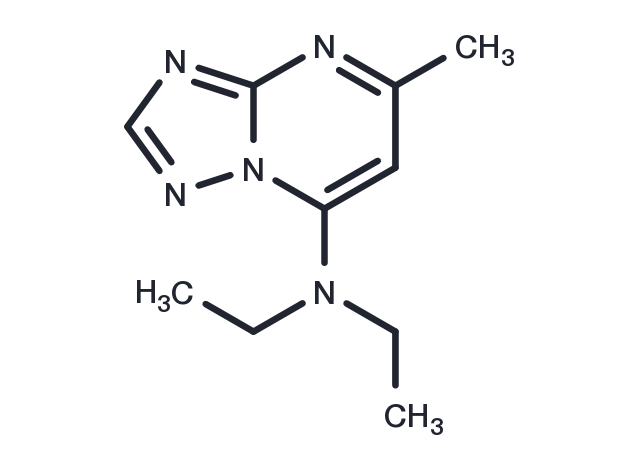Powder: -20°C for 3 years | In solvent: -80°C for 1 year


Trapidil (Avantrin) is a coronary vasodilator agent. It was originally developed as a vasodilator and anti-platelet agent and has been used to treat patients with ischemic coronary heart, liver, and kidney disease.

| Pack Size | Availability | Price/USD | Quantity |
|---|---|---|---|
| 5 mg | In stock | $ 42.00 | |
| 10 mg | In stock | $ 67.00 | |
| 25 mg | In stock | $ 129.00 | |
| 50 mg | In stock | $ 230.00 | |
| 100 mg | In stock | $ 353.00 | |
| 200 mg | In stock | $ 523.00 | |
| 1 mL * 10 mM (in DMSO) | In stock | $ 46.00 |


| Description | Trapidil (Avantrin) is a coronary vasodilator agent. It was originally developed as a vasodilator and anti-platelet agent and has been used to treat patients with ischemic coronary heart, liver, and kidney disease. |
| In vitro | Trapidil interrupts the autocrine loop at the PDGF and PDGF-receptor level.Trapidil has proved to possess a significant antiproliferative activity[1]. The addition of 100 to 400 μg/ml trapidil significantly reduced cell proliferation induced by different growth factors (FCS, PDGF-BB, bFGF, EGF), the highest inhibitory effect being on PDGF-BB stimulated Mesangial cell(MC) growth. The effect of the drug was dose-dependent and seemingly specific. Trapidil is an anti-platelet drug active against various aggregating agents, such as collagen, ADP, arachidonic acid, PAF and calcium ionophore. It exerts its action by blocking the biosynthesis of thromboxane A2 and antagonizing its effect at the receptor level, and by stimulating the synthesis and release of prostacyclin[2]. Trapidil strongly inhibited osteoclast formation in co-cultures of bone marrow cells and osteoblasts without affecting receptor activator of NF-κB ligand (RANKL) or osteoprotegerin expression in osteoblasts. In addition, trapidil suppressed RANKL-induced osteoclast formation from osteoclast precursors. Trapidil reduced RANKL-induced expression of nuclear factor of activated T cells, cytoplasmic 1 (NFATc1), a master transcription factor for osteoclastogenesis, without affecting the expression of c-Fos that functions as a key upstream activator of NFATc1 during osteoclastogenesis. Trapidil has also been reported to inhibit phosphodiesterase, thromboxane A2, and CD40 signaling and activate protein kinase A[3]. |
| In vivo | Trapidil is an antiplatelet drug with specific platelet-derived growth factor antagonism and antiproliferative effects in the rat and rabbit models after balloon angioplasty[1]. Trapidil had a potent inhibitory effect on osteoclast formation and bone resorption induced by interleukin-1 in an animal model. No abnormal symptoms, such as changes in body weight, diarrhea, high fever, and convulsion, were observed after intraperitoneal injections of trapidil[3]. |
| Cell Research | Cell viability was determined by Trypan blue dye exclusion test and LDH assay. Supernatants, collected from cells seeded in serum-free medium and exposed to the different mitogens and drugs tested, were centrifuged and LDH concentration determined. Supernatants obtained from sonicated cells were used as a positive control. Furthermore, to definitely exclude a cytotoxic effect of Trapidil on human MC, cells incubated for four days with and without the drug were challenged with fresh medium containing 10% FBS, and cell proliferation evaluated. (Only for Reference) |
| Synonyms | Rocornal, Trapymine, Avantrin, Trapymin, AR-12008 |
| Molecular Weight | 205.26 |
| Formula | C10H15N5 |
| CAS No. | 15421-84-8 |
Powder: -20°C for 3 years | In solvent: -80°C for 1 year
H2O: 38 mg/mL (185.1 mM)
Ethanol: 39 mg/mL (190 mM)
DMSO: 39 mg/mL (190 mM)
You can also refer to dose conversion for different animals. More
bottom
Please see Inhibitor Handling Instructions for more frequently ask questions. Topics include: how to prepare stock solutions, how to store products, and cautions on cell-based assays & animal experiments, etc.
Trapidil 15421-84-8 Angiogenesis Metabolism Tyrosine Kinase/Adaptors PDGFR PDE Rocornal inhibit Inhibitor Trapymine AR12008 Platelet-derived growth factor receptor Avantrin Trapymin AR 12008 AR-12008 inhibitor
